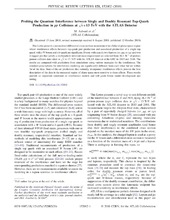Probing the quantum interference between singly and doubly resonant top-quark production in pp collisions at √s=13 TeV with the ATLAS detector
Aaboud, Morad; Aad, Georges; Abbott, Brad; Abdinov, Ovsat Bahram oglu; Abeloos, Baptiste; Abhayasinghe, Deshan Kavishka; Abidi, Syed Haider; AbouZeid, Hass; Abraham, Nadine L.; Abramowicz, Halina; Buanes, Trygve; Eigen, Gerald; Fomin, Nikolai; Lipniacka, Anna; Martin dit Latour, Bertrand; Mæland, Steffen; Stugu, Bjarne; Yang, Zongchang; Zalieckas, Justas; Bugge, Magnar Kopangen; Cameron, David Gordon; Catmore, James Richard; Feigl, Simon; Franconi, Laura; Garonne, Vincent; Gramstad, Eirik; Hellesund, Simen; Morisbak, Vanja; Oppen, Henrik; Ould-Saada, Farid; Pedersen, Maiken; Read, Alexander Lincoln; Røhne, Ole Myren; Sandaker, Heidi; Serfon, Cédric; Stapnes, Steinar; Vadla, Knut Oddvar Høie; Abreu, Henso; Abulaiti, Yiming; Acharya, Bobby S.; Adachi, Shunsuke; Adamczyk, Leszek; Adelman, Jareed; Adersberger, Michael; Adigüzel, Aytül; Adye, Tim; Affolder, Anthony Allen; Afik, Yoav; Agheorghiesei, Catalin; Aguilar Saavedra, Juan Antonio; ATLAS, Collaboration
Peer reviewed, Journal article
Published version

Åpne
Permanent lenke
https://hdl.handle.net/1956/20631Utgivelsesdato
2018Metadata
Vis full innførselSamlinger
Originalversjon
https://doi.org/10.1103/physrevlett.121.152002Sammendrag
This Letter presents a normalized differential cross-section measurement in a fiducial phase-space region where interference effects between top-quark pair production and associated production of a single top quark with a W boson and a b-quark are significant. Events with exactly two leptons (ee, μμ, or eμ) and two b-tagged jets that satisfy a multiparticle invariant mass requirement are selected from 36.1  fb−1 of proton-proton collision data taken at √s=13  TeV with the ATLAS detector at the LHC in 2015 and 2016. The results are compared with predictions from simulations using various strategies for the interference. The standard prescriptions for interference modeling are significantly different from each other but are within 2σ of the data. State-of-the-art predictions that naturally incorporate interference effects provide the best description of the data in the measured region of phase space most sensitive to these effects. These results provide an important constraint on interference models and will guide future model development and tuning.
